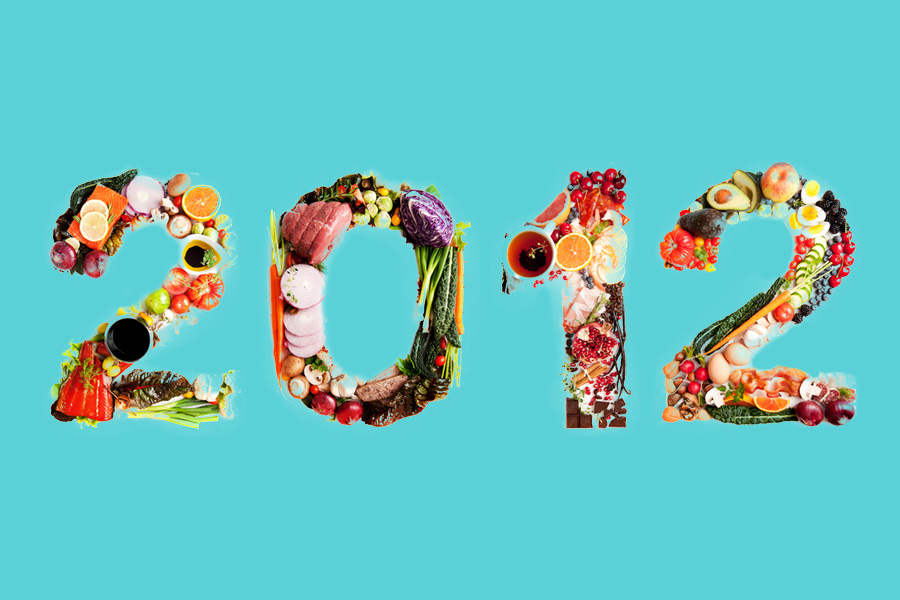It’s been quite a year for food and farming coverage here at Grist. Below is a wrap-up of some of the biggest stories of the year.
1. The worst drought in half a century
Corn withered, farmers scowled and resorted to feeding their cows candy, and many predicted the coming of the real Hunger Games. But the country’s worst drought in over 70 years was far more complex than most news sources reported. Most of that industrial corn was heavily propped up by crop insurance (supplemented with taxpayer dollars), while small farmers often remained invisible.  Even the silver lining — the Gulf “dead zone” shrank for the first time in years — turned out to be a little misleading, as next year’s rains could send more critter-killing farm nutrients into the Gulf of Mexico than ever before. And some scientists believed it was the corn and other huge monocrops that cover the region that were the problem because they leave farms especially vulnerable to changing weather patterns.
Even the silver lining — the Gulf “dead zone” shrank for the first time in years — turned out to be a little misleading, as next year’s rains could send more critter-killing farm nutrients into the Gulf of Mexico than ever before. And some scientists believed it was the corn and other huge monocrops that cover the region that were the problem because they leave farms especially vulnerable to changing weather patterns.
Do you want to know what’s really ominous? As of mid-December, Kansas, Oklahoma, and Texas still hadn’t gotten rain.

2. Organic takedown
Organics were in the headlines throughout 2012, but two stories grabbed most of the attention. And although they’re very different stories, they may have had surprisingly similar effects. The first was a New York Times article that took a much-needed critical look at the way the organic industry has grown and consolidated in recent years to the possible detriment of the federal organic standards. It was an intriguing piece, but, as I wrote back in July, the author may have overshot the mark when she implied that such changes have rendered the label meaningless.
The second, more hyped story hit the presses nearly two months later, when Stanford University compiled the existing science about nutrition in organic food, and claimed that organic was — again — virtually benefit-less. Many in the food world stepped up to point to the facts that a) most people buy organic food for reasons other than nutrition; and b) the science did in fact report significant differences where it mattered most (it showed lower pesticide residue in produce and little or no antibiotic residue in meat), but that didn’t stop many from trumping the “meaninglessness” of the label. My takeaway: Organic food isn’t a panacea, but I’m still awfully glad it’s an option.
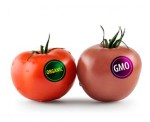
3. GMOs: No labels, but lots to keep track of
The food world watched closely this year as voters in California came surprisingly close (48.5 percent in the final tally) to voting to label genetically engineered (or GMO) ingredients in processed food, despite some nearly $45 million in opposition advertising from pesticide and big processed food companies. And considering the fact that it was one of the most visible food policy fights to pit grassroots organizers against Big Ag, the fact that the race was that close should give pessimists pause. If nothing else, it means the fight’s not over.
And it’s no wonder; the rest of this year’s GMO news can be easily seen as an argument for the importance of labeling. Scientists pointed to new evidence that genetically engineered seeds might lead to more herbicide use in large-scale farming (contrary to conventional wisdom); farmers battling herbicide resistant “superweeds” were encouraged to switch to stronger, older chemicals, and the U.S. Department of Agriculture put the onus on organic farmers to insure themselves against GMO contamination and told them they had to grow GMO sugar beets or face a sugar shortage. Optimists might take note of the fact that the Supreme Court began preparing to hear the case of a soybean farmer sued over seed patents in 2013 — a case which could put the brakes on one aspect of the biotech industry’s market domination. Either way, GMOs are probably worth paying attention to with or without labels.
4. Pink slime and beyond — food safety in the spotlight
“Pink slime” — the term used for Lean Finely Textured Beef treated with ammonia and used as an additive in conventional hamburgers — became a household name in March of 2012. The product had been in use for years, and its now-famous nickname had also been in effect for a while at that point. But the product made its big national debut on Jamie Oliver’s Food Revolution right around the time the news broke that school lunches around the nation were serving pink slime, and the rest was media history. Of course, as we reported, pink slime was just the tip of the iceberg when it comes to gross stuff in industrial meat.
In fact, there seemed to be no shortage of gross, toxic stuff in our food this year. Scientists found also a surprising quantity of arsenic in rice (hint: it gets into the soil via pesticides and fertilizer from factory farms, where chickens are fed arsenic as a growth promoter). But that’s not all. Eaters also found salmonella in peanut butter, cantaloupe (again), ground beef, tuna scrape (those extra bits they use in spicy tuna rolls), and dog food. In fact, there were so many food safety frights this year, and so little sign that the Food and Drug Administration was planning to do anything about it, that several news outlets declared food safety in this country a big old failure.
Meanwhile, the U.S. Department of Agriculture moved forward with plans to “modernize” — and by that they mean privatize — part of its meat and poultry inspection program. It’s a change that could make industrially produced poultry a lot crappier (literally).
5. The farm bill that wasn’t
Barring some kind of last-minute aberration, it’s looking like the giant, multibillion-dollar food and farming bill will have made it though an entire year of negotiations and non-negotiations (in equal parts) without moving an inch. Grist tracked the farm bill’s “progress” through the course of 2012, looked closely at what lawmakers proposed on both sides of the aisle, and the implications for the big picture. We’ve collected the bulk of our farm bill coverage here, but to make a long story short: good food movement advocates want to keep federal funding in place for things like on-farm conservation, food stamps, and organic farming, while reducing the giant subsidies for big commodity farms. Farm-state lobbyists — and the GOP-controlled House — want just the opposite. What happens if the farm bill goes over the fiscal cliff? Well, it looks like farm policy might just go back to the future.

Ron Gautreau
6. Something’s fishy
With all the attention seafood fraud has received this year, you’d think it was all that was going on in the seafood world. Sure, no one wants rockfish when they’re paying for halibut, but the ocean (and the food we grow there) might warrant your attention for a few other reasons. We reported on the ongoing effort to keep small “forage” fish from being completely wiped out by an industry that feeds factory farm animals, for instance, as well as the recent, shocking move by the FDA to clear the way for the approval of GMO salmon, and the crucial relationship between mercury, the burning of fossil fuels, and seafood. We also helped sound the alarm about oysters, which are in danger thanks to the increasing acidification of the ocean and have inspired scientists and farmers to work together in a rare partnership. We also highlighted several attempts to crack the elusive “sustainable aquaculture code,” including this barramundi operation, an experimental deep water operation, and this project, which farms multiple edible species at once in the waters right outside New York City.
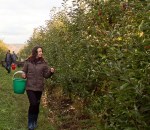
Vamapaull
7. Urban farming: Blowing up
On the positive side, 2012 proved that urban farms are much more than a passing trend. Take the impressive food forest planned for Seattle, or the artist who took to grafting fruit-bearing branches onto ornamental city trees in San Francisco. How about this bee corridor? Or this giant urban farm corridor developers are planning for Chicago’s South Side? There is so much inspiring work happening on the urban farming front that several great projects sprouted this year simply to take stock of the abundance of urban farms around the country. Grist also heard from city farming legend Will Allen on the advent of the book he released. And we explored tough questions like: Can urban farms get too big? Are urban homesteaders clueless about class? And what exactly is the relationship between growing food and gentrification, anyway?

Local Food Hub in Virginia takes care of distribution for local growers.
8. Local food: Scaling up
The bad news is very few companies produce the bulk of our food, and this consolidated system puts the squeeze on both food producers and consumers. But 2012 also saw great strides in the growth of an alternative, localized system. Yes, this was the year “food hub” became a buzz word, and people all over began stepping up public and private efforts to get more local food to more people. From plans to grow and distribute food from an old prison in Illinois and mondo greenhouses outside Washington D.C.; to funds that allow ordinary people to pool their dollars to support small producers; the rapid expansion of large community-supported agriculture (CSA) box subscription services; new USDA grants for value-added foods; and other important efforts on the part of the government to boost local food infrastructure. One thing is clear: People want a choice, and choosy people want local food.
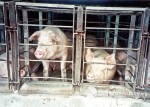
Farm SanctuaryTemple Grandin has said raising pigs in gestation crates is like “living in an airplane seat.”
9. More meat, less meat, better meat?
Factory farms aren’t going anywhere. In fact, several states have seen a rise in the number of concentrated animal farming operations (CAFOs) this year — mostly to satisfy the growing international demand for meat. These farms are still bad for the nearby land, water, and air — not to mention the animals and people involved. (In fact, some scientists are actually documenting the way factory farms impact the health of nearby residents.) CAFOs are also where a whopping 80 percent of the antibiotics in this country get put to use every year — a fact that correlates directly to the rise in antibiotic-resistant infections.
But there are many encouraging signs of change. For one, 2012 saw an amazing number of businesses — from the uber-progressive Bon Appetit Management Company to less likely candidates such as Burger King and Sysco — phase out some of the least humane practices in animal agriculture today: the use of confining gestation crates for sows.
This year also brought wind of all kinds of inspiring alternative projects. We featured a Food Inc. chicken farmer’s new, pasture-based operation, a humane farm deep in the heart of CAFO country, a group of young farmers raising heritage breeds in the Sierras, and an agroforestry expert who is grazing animals in perennial fruit and nut orchards as a way to create healthy soil and sequester carbon. And, on the macro level, we looked into a few promising experiments that could be a game changer for pasture-based systems: A business creating a national network of pastured egg operations and the first grass-fed beef mega-farm.
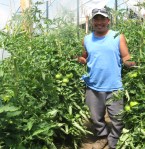
Gathering Together Farm
10. Food workers became slightly less invisible
You can’t have truly sustainable food if the people who made it are working in substandard conditions. And while food workers have traditionally gotten the short end of the stick (only 13 percent earn a living wage), 2012 may just have been the year that labor issues entered the food conversation in earnest on a national level. Organizers collected important data about workers throughout the food chain [PDF] and the media responded. Fast-food employees went on strike. Chipotle signed onto an agreement to support fair working conditions for tomato pickers after resisting for years; students on a variety of campuses pushed for more rights for cafeteria employees; and the small but important domestic fair trade effort began to take root. Now the question is: If Obama’s next term brings immigration reform, will it truly help the people who grow, harvest, transport, pack, ship, and cook the food we eat? Only time will tell.
What did we miss? Tell us which food and farming stories stuck out to you this year.

